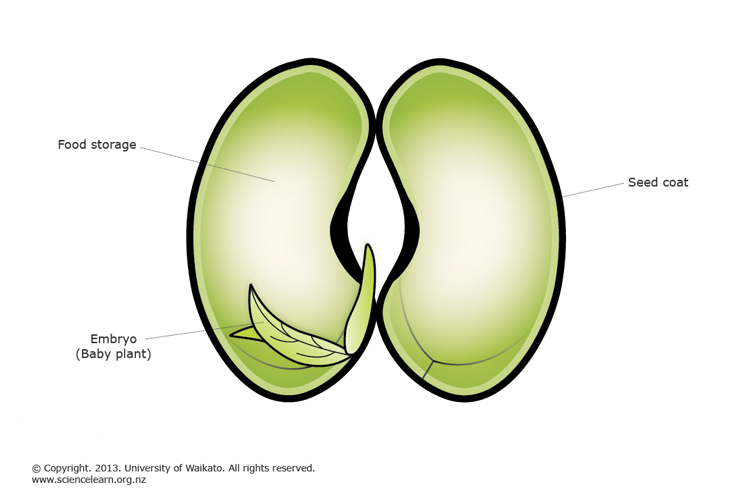Bean Embryo
Have you ever wondered about the tiny beginnings of a bean plant? The bean embryo is a small but mighty structure that gives birth to the new plant, and it's worth exploring further.
Many people may not realize that the bean embryo is crucial for the growth and development of a new bean plant. Without a healthy embryo, the plant may not grow properly or may not even sprout at all. However, there are several ways that the growth of a bean embryo can be inhibited, whether from environmental factors or genetic issues.
The target of the bean embryo is to serve as the seed for the new plant. Inside the bean seed, the embryo contains everything it needs to begin germinating, from the first roots and leaves to the energy stores to sustain its growth. When conditions are right, such as when the seed is planted in soil and receives the proper amount of water and sunlight, the embryo comes to life and begins to grow into a new plant.
In this article, we will explore the bean embryo and its role in the growth of bean plants. We'll dive into the anatomy of the bean embryo, factors that can affect its growth, and tips for nurturing healthy bean plants.
The Anatomy of a Bean Embryo
As mentioned earlier, the bean embryo is the structure inside the bean seed that serves as the new plant's beginning. It's made up of several distinct parts, including the cotyledons, radicle, hypocotyl, and epicotyl.
The cotyledons fill up most of the seed and serve as the plant's initial energy source. When the plant sprouts, the cotyledons split open to reveal the first leaves. The radicle is the embryonic root, which anchors the plant into the soil and begins to absorb water and nutrients. The hypocotyl is the area between the radicle and cotyledons, while the epicotyl is the portion above the cotyledons.
Understanding these different parts of the bean embryo can help gardeners and growers recognize healthy and mature bean seeds, as well as diagnose any problems that may arise with seed germination.
Promoting the Growth of Bean Embryos
As with any plant, promoting the growth and development of bean embryos requires the right conditions. One of the most important factors is ensuring that the soil is healthy and rich in nutrients. Bean embryos need plenty of water and sunlight, but they also require sufficient amounts of nitrogen, phosphorus, and potassium to thrive.
Additionally, gardeners should avoid planting bean seeds too deeply in the soil, as this can inhibit their growth. Planting seeds at a depth of 1-2 inches is usually sufficient. It's also important to keep the soil moist but not too wet, as excessive water can lead to fungal growth and root rot.
Finally, gardeners should be mindful of environmental factors such as temperature and humidity. Bean embryos prefer moderate temperatures between 60 and 80 degrees Fahrenheit, and high humidity levels can promote healthy seed germination.
Factors That Can Inhibit Bean Embryo Growth
Despite our best efforts, sometimes something can go wrong with the growth of bean embryos. There are several factors that can inhibit their growth, including:
- Temperature extremes
- Poor soil quality with low nutrient levels
- Disease or pests
- Overwatering or underwatering
- Planting too deeply in the soil
Gardeners should keep an eye out for these signs and troubleshoot any problems as they arise. If a bean embryo seems stunted or unhealthy, it's best to remove the seed and try again with a new one.
Tips for Nurturing Healthy Bean Plants
If you're interested in growing your own bean plants, there are a few tips you can follow to promote healthy growth:
- Choose a sunny and well-draining location for planting
- Water bean plants regularly, but avoid getting the leaves wet
- Fertilize the soil with a balanced, all-purpose fertilizer
- Mulch around plants to retain moisture and prevent weeds
- Harvest beans when they're fully mature and before they dry out
Questions and Answers
Q: Can you eat bean embryos?
A: Technically, yes, you can eat bean embryos. However, they're usually not consumed as they're not particularly tasty and can be quite small in size compared to the rest of the bean.
Q: How long does it take for a bean embryo to germinate?
A: It typically takes between 4 and 10 days for bean embryos to germinate, depending on the temperature and moisture levels.
Q: Can bean embryos be frozen?
A: Yes, bean embryos can be frozen for up to a year if properly sealed and stored.
Q: Can bean embryos be grown hydroponically?
A: Yes, bean embryos can be grown hydroponically, but they require specific nutrients and environmental conditions to thrive without soil.
Conclusion of Bean Embryo
The bean embryo may be small, but it's a critical component of the new plant's growth and development. By understanding the anatomy of a bean embryo and promoting the proper conditions for seed germination, gardeners and growers can enjoy healthy bean plants with bountiful harvests. Whether you're a seasoned gardener or just starting out, growing beans from seed is a fun and rewarding experience.
Gallery
Bean Seed Embryo — Science Learning Hub

Photo Credit by: bing.com / seed embryo bean plant reproduction science into which two contains system cotyledons learning develops main
Ritter's AP Bio Plant Baby Book: Ultra Sound

Photo Credit by: bing.com / plant embryo bean baby ultra ritter bio ap book
Bean Seed Embryo - Stock Image - C043/3410 - Science Photo Library

Photo Credit by: bing.com / embryo
Dissect A Bean Seed Lab! | Preschool Powol Packets

Photo Credit by: bing.com / bean seed lab dissect dissection beans parts seeds cotyledon kidney embryo dissected cut preschool label printable split kids bury alive
Teaching In Peru: Growing...

Photo Credit by: bing.com / parts seed beans soaked bean dissected peru teaching coat betterlesson then water first lesson grade